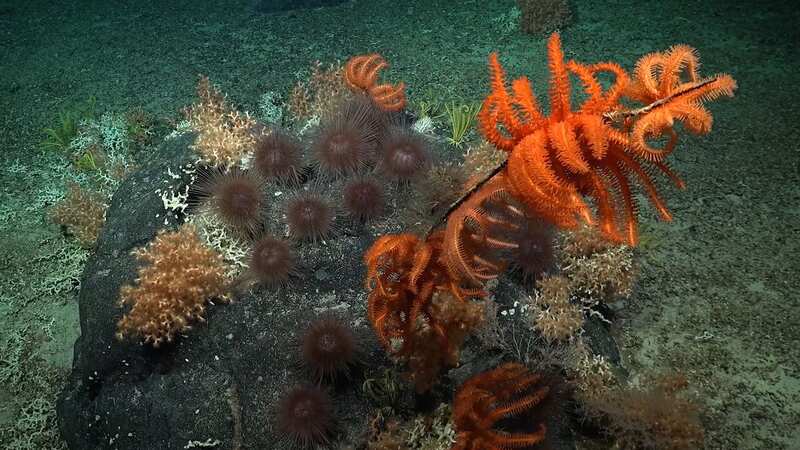Hundreds of 'alien-like' species discovered on underwater mountains

Over 100 new species that look like they're from another planet have been found living on underwater mountains off the coast of Chile.
A team of scientists from around the world visited these unexplored seamounts, which are as tall as 3,530 metres, and discovered loads of creatures they'd never seen before. The experts managed to map over 52,777 square kilometres of the ocean floor, going as deep as 4,500 metres.
They found deep-sea corals, sponges, sea urchins, amphipods, squat lobsters and other species they think are completely new to science. The research team, led by the Schmidt Ocean Institute (SOI), used a remote-controlled underwater robot to explore the marine life at these massive underwater mountains. They explored the Nazca and Salas y Gomez Ridge, both inside and outside of Chile's waters, to collect data that could help protect these areas in the future.
Lots of companies want to mine these underwater mountain ranges for their natural minerals, like cobalt. But previous tests have shown that this mining would destroy the lively communities of mostly undiscovered marine life that live there.
The Salas y Gomez Ridge is a massive underwater mountain chain that's 2,900 kilometres long. It's made up of over 200 seamounts and stretches from the coast of Chile to Easter Island in the south eastern Pacific Ocean. Most of this underwater mountain ridge isn't owned by any country.
 Jake Paul calls on John Fury to make retirement bet for fight with son Tommy
Jake Paul calls on John Fury to make retirement bet for fight with son Tommy
The scientists also visited two protected marine areas in Chile: the Juan Fernandez and Nazca-Desventuradas marine parks.
During their trip, they used an underwater robot called SuBastian. This robot can go down to depths of up to 4,500 metres - that's 14.5 times taller than The Shard in London! They used it to gather data from ten seamounts.
All ten of these seamounts will help Chile protect its marine life. The team of international researchers found that each seamount was home to lots of different ecosystems. Many of these were identified as being at risk.
These included deep-sea coral reefs and sponge gardens that were full of life. They also found brightly-coloured and mysterious species of fish, lobster and amphipods that humans have probably never seen before.
Experts are now studying the physical features and genes of the specimens to see if they are new species that science hasn't discovered yet.
The scientists on the expedition mapped a total of 52,777 sq kms of the seafloor. They discovered four seamounts within Chilean waters. The tallest of the four seamounts, standing at a whopping 3,530 meters and explored for the first time, was given the unofficial name 'Solito' by the team of scientists.
Dr Javier Sellanes, from Universidad Catolica del Norte in northern Chile, was surprised by the number of new species his team discovered.
"We far exceeded our hopes on this expedition," he said. "You always expect to find new species in these remote and poorly explored areas, but the amount we found, especially for some groups like sponges, is mind-blowing.
"These thriving and healthy ecosystems show that the Nazca-Desventuradas and Juan Fernandez Marine Parks are doing a great job protecting delicate marine habitats."
A second trip on the Research Vessel Falkor is planned to further explore the Salas y Gomez Ridge. Underwater dives from the expedition will be shown live on the SOI's YouTube channel as scientists explore areas deeper than 600 meters depth for the first time.
 Tommy Fury 'moves out' of mansion shared with Molly-Mae ahead of Jake Paul fight
Tommy Fury 'moves out' of mansion shared with Molly-Mae ahead of Jake Paul fight
California-based charity SOI will also be exploring the Southeast Pacific in the coming year, looking at the waters off Peru and Chile. Dr Jyotika Virmani, the Institute's Executive Director, added: "Full species identification can take many years, and Dr Sellanas and his team have an incredible number of samples from this amazingly beautiful and little-known biodiversity hotspot.
"Schmidt Ocean Institute is a partner with the Nippon Foundation - Nekton Ocean Census Program, which has set a target of finding 100,000 new marine species in the next 10 years and, once identified, these new species will be a part of that."
Read more similar news:
Comments:
comments powered by Disqus

































